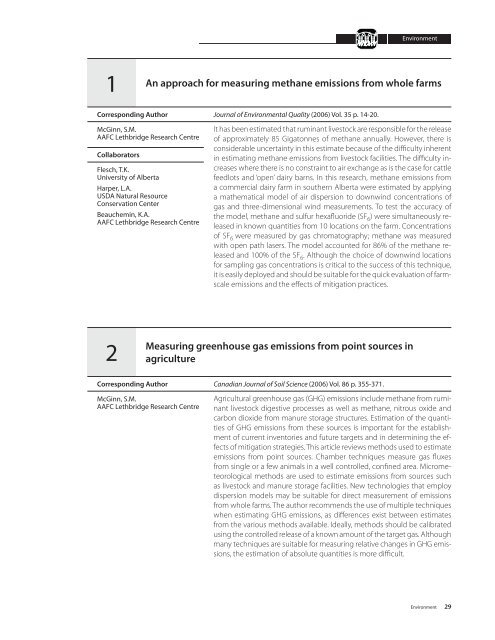A52-75-2007E.pdf - AgroMedia International Inc
A52-75-2007E.pdf - AgroMedia International Inc
A52-75-2007E.pdf - AgroMedia International Inc
You also want an ePaper? Increase the reach of your titles
YUMPU automatically turns print PDFs into web optimized ePapers that Google loves.
Environment1An approach for measuring methane emissions from whole farmsCorresponding AuthorMcGinn, S.M.AAFC Lethbridge Research CentreCollaboratorsFlesch, T.K.University of AlbertaHarper, L.A.USDA Natural ResourceConservation CenterBeauchemin, K.A.AAFC Lethbridge Research CentreJournal of Environmental Quality (2006) Vol. 35 p. 14-20.It has been estimated that ruminant livestock are responsible for the releaseof approximately 85 Gigatonnes of methane annually. However, there isconsiderable uncertainty in this estimate because of the difficulty inherentin estimating methane emissions from livestock facilities. The difficulty increaseswhere there is no constraint to air exchange as is the case for cattlefeedlots and ‘open’ dairy barns. In this research, methane emissions froma commercial dairy farm in southern Alberta were estimated by applyinga mathematical model of air dispersion to downwind concentrations ofgas and three-dimensional wind measurements. To test the accuracy ofthe model, methane and sulfur hexafluoride (SF 6 ) were simultaneously releasedin known quantities from 10 locations on the farm. Concentrationsof SF 6 were measured by gas chromatography; methane was measuredwith open path lasers. The model accounted for 86% of the methane releasedand 100% of the SF 6 . Although the choice of downwind locationsfor sampling gas concentrations is critical to the success of this technique,it is easily deployed and should be suitable for the quick evaluation of farmscaleemissions and the effects of mitigation practices.2Measuring greenhouse gas emissions from point sources inagricultureCorresponding AuthorMcGinn, S.M.AAFC Lethbridge Research CentreCanadian Journal of Soil Science (2006) Vol. 86 p. 355-371.Agricultural greenhouse gas (GHG) emissions include methane from ruminantlivestock digestive processes as well as methane, nitrous oxide andcarbon dioxide from manure storage structures. Estimation of the quantitiesof GHG emissions from these sources is important for the establishmentof current inventories and future targets and in determining the effectsof mitigation strategies. This article reviews methods used to estimateemissions from point sources. Chamber techniques measure gas fluxesfrom single or a few animals in a well controlled, confined area. Micrometeorologicalmethods are used to estimate emissions from sources suchas livestock and manure storage facilities. New technologies that employdispersion models may be suitable for direct measurement of emissionsfrom whole farms. The author recommends the use of multiple techniqueswhen estimating GHG emissions, as differences exist between estimatesfrom the various methods available. Ideally, methods should be calibratedusing the controlled release of a known amount of the target gas. Althoughmany techniques are suitable for measuring relative changes in GHG emissions,the estimation of absolute quantities is more difficult.Environment 29





